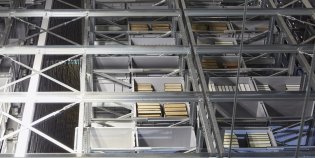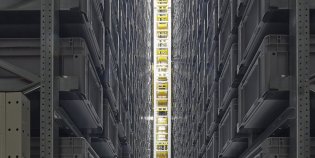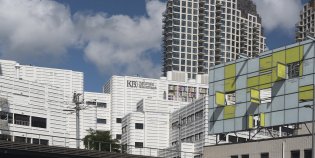The KB is set to build an innovative, new book repository in which the National Library will store the Netherlands’ printed and written heritage safely and sustainably for the long term. The repository is being designed by Office Winhov and will be located in the Harnaschpolder district of the municipality of Midden-Delfland. If everything goes according to plan, the new repository will be fully operational by 2028.
As the current KB building no longer meets the standards for safe storage conditions, the Dutch Central Government Real Estate Agency has commissioned the development of new repository for the KB’s national written heritage collection. The future repository will be a secure, energy-neutral, long-term storage facility. It will be almost fully automated, with a robot installation managing the collection and allowing the millions of books, newspapers and magazines to be kept in low-oxygen conditions. This reduces the risk of fire to an absolute minimum. The indoor climate (temperature and humidity) will be regulated without a water-bearing climate control system, which will benefit the long-term preservation of the national collection.
Special design
Lily Knibbeler, Director General of the KB, is delighted that with the selection of Office Winhov this new building project has progressed to the next stage. ‘Office Winhov’s ideas corresponded most closely with the vision that the Central Government Real Estate Agency and the KB had for the new repository. We’re now keen to see the final design.’
The new building must do justice to the past, present and future of the National Library, explains Knibbeler. ‘We don’t just store everything that was ever published in and about the Netherlands, but also material that is published today and in the future. The new building must be innovative and future-proof to ensure that our collection remains accessible to all. We are confident that Office Winhov will come up with a special design that meets this unique requirement.’
Jan Peter Wingender, partner at Office Winhov architects, says he feels honoured to have been selected to design the new book repository for the KB. ‘We are enormously excited about creating a design that can withstand time and safeguard the contents of the building. We want to design a contemporary façade that reflects the materiality of paper, the curvature of an open book, the relief of printed matter and the sheer mass of the books stored inside.’
Continually on the move
This is not the first time that the collection managed by the KB has needed a new home. When it started in 1798, the collection of the National Library of the Netherlands was housed in the Binnenhof in The Hague. In 1807, it was moved to the Mauritshuis, but the organisation soon outgrew these premises too. In 1821, the library moved to Huis Huguetan on Lange Voorhout, which had to be extended onto the Kazernestraat in 1908 - a building that was extended again in 1956. The current 1970s-building on Prins Willem Alexanderhof has housed the KB since 1982.
New step
‘We store the entire collection of the Netherlands’ written heritage, both printed and digital, so we will never stop growing. There is plenty of room to grown on these new premises’, says Knibbeler. Although the KB is no stranger to moving house, separating the book repository from the public building is a new step for the library. Knibbeler has no qualms about this: ‘The British Library and the Speicherbibliothek in Büron, Switzerland, are already using external, automated book repositories. They usually deliver books that are requested to the public building within a day. We will provide the same service.’
According to Knibbeler, the separation means that the enormous heritage collection can be stored sustainably, compactly and securely, while the public function of the KB in the centre of The Hague can be continued and modernised: ‘This is where the KB will continue to bring people and words together.’





